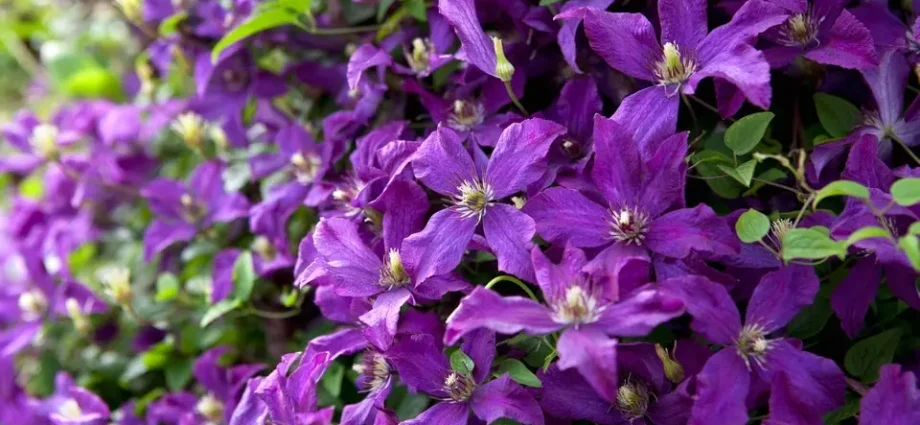Contents
Many flower lovers, having first met clematis, consider them too complex and capricious to grow. But this is not always true. There are varieties, as if specially created for beginner gardeners. For example, Clematis Polish Spirit, despite its rather advanced age, does not lose popularity. And all thanks to the amazing adaptability to almost any environmental conditions, as well as long and abundant flowering.

Description of Clematis Polish Spirit
The name of this variety of clematis already speaks of the pride of its creator for his creation. It is translated from English as “Polish spirit” or “Spirit of Poland”. The variety was obtained back in 1984 by the famous Polish breeder Stefan Franchik, and in 1990 it was presented to the public by Raymond Evison. Clematis Polish Spirit was awarded the British Royal Floricultural Society with a high rating – its creator received a medal of merit in horticulture. And indeed, from that time to the present day, this variety of clematis is best known for its unpretentiousness and abundance of long flowering. This variety is especially popular in Japan, in the USA and in European countries.
Clematis Polish Spirit is distinguished by its extraordinary growth and flowering energy, this is clearly seen in the photo below:

In height, the liana can reach 3,5-4 m, and in width the bush can grow up to 80-100 cm. Moreover, under favorable conditions, clematis of this variety can reach similar sizes already for 2-3 years of development.
The variety belongs to the group of large-flowered clematis. The diameter of the flowers reaches 12-16 cm. The flowers are not double, wide open, with flat, slightly corrugated petals along the edges. Petals in an amount of 4 to 6 pieces are separated from each other at a decent distance. The color is dark purple with a slight purple tint in the center of the petals. In the descriptions of flowers of Clematis Polish Spirit from several reviews of flower growers, lighter stripes are sometimes present on the petals. Apparently, this may depend on the composition of the soils on which the liana lives.
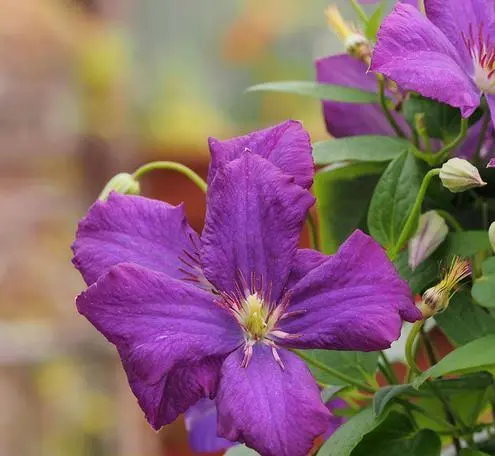
Pronounced reddish stamens with a white base give the flower additional showiness. The fruits that form after flowering are an achene up to 8 mm long, squeezed from both sides.
Clematis Polish Spirit is usually attributed to the Vititsella group, but recently in some circles of flower growers it is more likely to be attributed to the Jacqueman group (that is, to large-flowered late-flowering varieties). But this opinion is not yet well-established and rather controversial, and most flower growers habitually attribute it to the Vititsella group.
The flowering time of this clematis variety is really quite late, but very long in time. The appearance of the first flowers is possible at the end of June, but then the waves of flowering last one after another, without interruption until the middle or end of October. Moreover, the abundance and duration of flowering of the Polish Spirit variety practically does not depend on weather conditions and is possible even in cloudy or rainy weather.
Despite the fact that, according to the description, the Clematis variety Polish Spirit is well suited for growing in regions with cold winters, in the first years after planting in the northern regions, the root zone will still require shelter as in the photo.
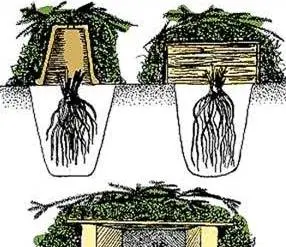
In this form, it is able to withstand frosts down to -34 ° C.
In addition, clematis is characterized by excellent resistance to various diseases. Especially if you choose the right place for planting and follow all the rules of cultivation.
Clematis pruning group Polish Spirit
Clematis varieties Polish Spirit forms flowers only on the shoots of the current season, which means that it can be safely attributed to the third pruning group (strong).
Optimal growing conditions
Clematis Polish Spirit belongs to varieties that are unusually adapted to any of the most difficult climatic conditions. But, of course, he will feel best at not too hot, but always warm summer temperatures. It can tolerate short-term drought, but the most abundant flowering will be observed under the condition of constant and moderate moisture. Of course, like all members of his family, Polish Spirit disapproves of drafts and strong winds. Therefore, they usually plant it under the protection of either some kind of building, or in a place where strong gusts of wind are rarely observed.
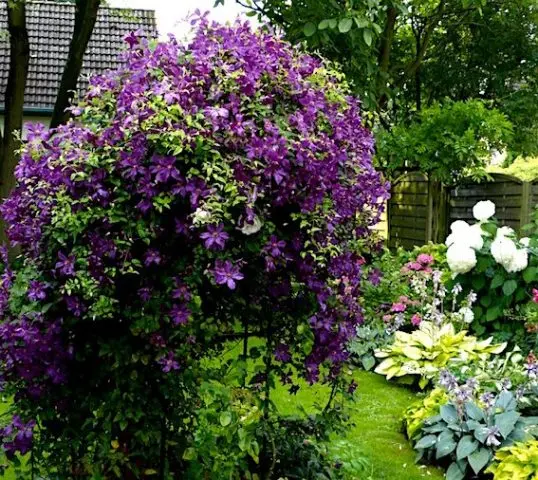
Since it does not have special requirements for lighting, it will feel good near trees with a not very dense crown.
Planting and caring for Clematis Polish Spirit
With the general undemanding nature of this variety, for its better survival and luxurious flowering, one should still remember the rules of planting and care that are necessary for each clematis.
Selection and preparation of the landing site
In terms of lighting, only places on the north side of various buildings are clearly not suitable for him. There may not be enough light for clematis. Anywhere else Polish Spirit will feel great. When planting in the southern regions, it is better to take care of shading the bush during the hottest midday hours.
The most important thing that any clematis cannot stand is the constant stagnation of moisture in the root zone. Bushes of this variety should not be planted in lowlands or places where the groundwater level is quite high.
Clematis Polish Spirit will grow especially well in fertile, not too heavy, loose soil with a neutral to slightly alkaline reaction. If acidic or heavy soils are observed on the site, then the planting pit must be prepared in advance and filled with suitable soil.
Seedling preparation
The easiest way to use for planting is a well-developed two-year-old clematis seedling with a closed root system. However, rooted cuttings and small shoots are also quite viable for planting in the spring, but will require special attention in the first year of life. In general, in cold regions, it is recommended to plant clematis in the spring, in April-May. Before disembarking, it should be kept as cool as possible, pinching the shoots if they begin to develop intensively in the heat.
In the south, where warm weather often lasts until the end of October-November, it is quite possible to plant clematis in the fall. It is only important to ensure that several well-developed vegetative buds are necessarily present on the plant. If the seedling of Polish Spirit was purchased in the fall, and the soil has already frozen slightly, then it is better to save it until spring. To do this, the roots are sprinkled with a moistened mixture of sand and sawdust and placed in a cold place, at a temperature of about + 5 ° C.
The day before planting, the clematis root system is in any case thoroughly moistened with warm water with the addition of growth stimulants.
Rules of landing
The dimensions of the pit for planting should be approximately 50x50x50 cm. This is especially important in the case of unsuitable land for planting clematis on the site. A drainage layer at the bottom of the landing pit is required. Its height should be at least 15-20 cm so that water never stagnates in the root zone. Chipped brick, crushed stone, pebbles can be used as drainage.

The planting mixture is made up of:
- 2 parts of garden soil;
- 1 part humus or compost;
- 1 parts sand;
- a small amount of wood ash and a handful of complex fertilizer.
The scheme of actions during landing is traditional:
- The bottom of the landing pit is 1/3 covered with the prepared mixture.
- Clematis roots are spread on top of it.
- Gradually cover them with earth, making sure that the root collar is not under the ground.
- From above, the root zone of the planted plant must be mulched with a mixture of coarse sand and dry grass.
- To protect young clematis from too bright sun, low annuals (calendula, marigolds) or perennials with small roots (irises, chamomile) are planted in the root area.
When planting several clematis bushes, it is advisable to leave a distance of at least 70-80 cm between them.
Watering and top dressing
Despite the fact that clematis cannot stand stagnant water in the roots, they need regular and fairly plentiful watering. Under normal conditions, it is enough to water the plants once a week. For young seedlings, about 1 liters of water are used, adult clematis will need much more – up to 10-3 buckets per bush.
In hot and dry summers, clematis can be watered two or three times a week. It is necessary to ensure that moisture is always present in the soil, but at the same time the soil is not too damp.
In the first year after planting, young clematis plants do not need to be fed if the necessary fertilizers were used to create the nutrient mixture.
As for adult plants, they are watered for the first time with the addition of nitrogen fertilizers in the spring, when leaves and shoots bloom. Then, when forming buds, watering is used with the addition of potash supplements. After flowering, phosphate fertilizers are applied.
Mulching and loosening
Loosening is a very useful procedure for saturating the upper layers of the soil with oxygen, but clematis has a chance of damaging the roots. Therefore, it is best to mulch the root zone with a good layer (at least 10 cm) of organic material, which is added under the bush every autumn. It is desirable that wood ash and coarse sand be present in the mulch. They protect the roots of clematis from various rots.
Garter
Clematis Polish Spirit is a very powerful vine and for intensive growth it needs a reliable and strong support. It is installed, as a rule, when planting a bush, so as not to disturb its roots later. When landing near a wall, it is necessary to leave a distance of 30 cm from it.
It is necessary to tie up all the main shoots of young clematis to the support immediately after planting. In the future, its leaves and shoots easily cling to any auxiliary elements and wrap around fences, poles, arbors, creating a real green flowering wall. For the best branching, the top of the vine at the beginning of growth can be pinched.
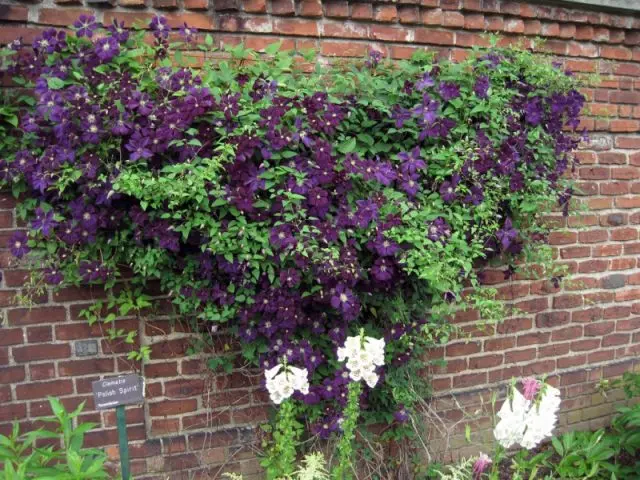
When planting Clematis Polish Spirit in a certain place, it is important to remember the dark purple tone of its flowers. It is desirable that the shade of the background on which it will grow be light, otherwise the overall picture will turn out to be too bleak.
Trimming
Clematis Polish Spirit belongs to the third pruning group. This means that his flowers form only on young shoots of the current season. Old branches will still not bloom. For this reason, they can be easily removed in the fall to ensure the creeper has a trouble-free wintering. Thus, a few weeks before the onset of persistent frosts, Polish Spirit clematis are cut completely close to ground level, leaving only a few buds for development in the next season. It is from them that the active growth of young shoots will begin in the spring.
When growing the Polish Spirit variety in relatively warm regions, you can try to leave 1-2 shoots for the winter, after shortening them. In this case, you can expect them to bloom earlier.
Preparation for winter
The winter hardiness of Clematis Polish Spirit is determined primarily by its strong pruning. But the root zone in areas with severe frosts must be well insulated, protecting the bushes from decay.
At the first frost, the base of the bushes is covered with an additional layer of mulch. After pruning, all that is left of clematis is covered with dry foliage, and covered with a wooden box on top. From above, you can cover with a small layer of spruce branches so that the shelter is not dispelled by strong winds.
Reproduction
The easiest way to propagate the Polish Spirit variety is by layering or by dividing the bush. The seed method of reproduction is very laborious and is used only in breeding work.
For dividing bushes choose plants that have reached the age of 5 years. The bushes are carefully dug up in the spring, and the rhizome is divided into several pieces with several buds. Each division is planted in its own place.
In spring, young shoots of clematis with several internodes can also be tilted to the ground and lightly covered with soil. In autumn, rooted shoots are separated from the mother plant and planted separately.

Diseases and pests
Diseases usually affect clematis plants weakened from improper care. The most common disease affecting clematis is wilt. It is characterized by sudden wilting of leaves and stems. The plant is difficult to save, the soil must be disinfected with a solution of foundationol.
Diseases such as rust (brown coating on the leaves) and powdery mildew (white coating) are treated by spraying with Bordeaux mixture and other fungicides. Damaged leaves are stripped and burned.
Among the pests, there are underground inhabitants that damage the roots of clematis (bears, moles, mice, nematodes) and above-ground pests (snails, slugs, aphids). To combat them, specialized toxic substances and baits are used.
Conclusion
Clematis Polish Spirit will be a real gift for a beginner grower who wants to decorate his site with an attractive and abundantly blooming liana.










